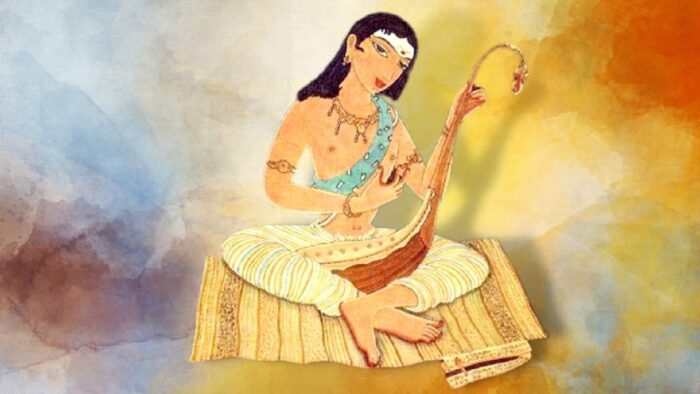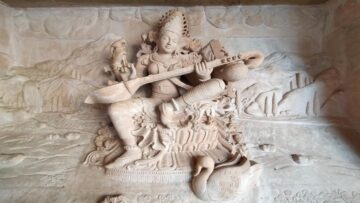One of my favourite songs is https://www.youtube.com/watch?v=YPFA5hdwye0.
In this popular song from the movie ‘Chupke Chupke’ playback singers Mohammed Rafi and Kishore Kumar have recited the taana containing the first four svaras – Sa, Re, Ga, Ma.
Indian classical music consists of seven musical notes or svaras. The sapta (seven) svaras in their natural ascending order are Sa, Re, Ga, Ma, Pa, Dha, Ni. Together the seven svaras are called Saptak (सप्तक).
The subsets of the saptak are called taanas (तान). When the svaras of a taana are arranged in their natural ascending order the taana is called the sapat or shuddha taana. In koot taana the svaras are not in order. The seven svaras can be arranged in 7! = 5040 ways. Enlisting of all the possible arrangements / taanas is called the taana prastaar (प्रस्तार, meaning to unfold or to open up).
Systematic study of combinatorics in music was done Sarngadeva (शार्ङ्गदेव) (1225 CE) in his book Sangitaratnakara (सङ्गीतरत्नाकर).
In a taana prastaar, all the taanas are arranged in a specific order. So that given a taana you can calculate its row number in the prastaar and given a row number you can generate the arrangement of the svaras. Sarngadeva had given pratyayas or algorithms in Sangitaratnakara for accomplishing these.
Before discussing Sarngadeva’s pratyayas let’s analyse the generation of taana prastaar by generating the prastaars ourselves. We will follow a rule that the first taana of the prastaar will be the shuddha taana and the last one will be the reverse of the first one. For example, as in the above song, S R G M will be the first taana and its reverse M G R S will be the last one in a 4 svara taana prastaar.
Let us first consider two svara taana prastaars.
For the first example let us take the first two svaaras Sa and Re. The first taana of the prastaar will be the natural order of the svaras S R and the second and last taana will be the reverse order R S. Refer Table 1.

Table 1
We can also take Re and Ga for the taana prastaar. Refer Table 2.

Table 2
Now let us consider a taana prastaar with Sa and Ga. Refer Table 3.

Table 3
Now let us consider a 3 svara taana prastaar with the first three svaras Sa, Re and Ga. A 3 svara taana prastaar will have 3! = 6 taanas. The first taana of the prastaar will be the natural order of the svaras S R G and the last taana will be the reverse order G R S. The 3 svara taana prastaar will have three 2 svara prastaars embedded within it. Refer Table 4.
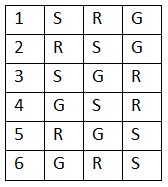
Table 4
Let us draw a tree graph for a clear understanding of the sequence of taanas in the prastaar.
To understand more about tree graphs kindly watch my video at:
https://www.youtube.com/watch?v=XmuJcGYmPHg&t=12s
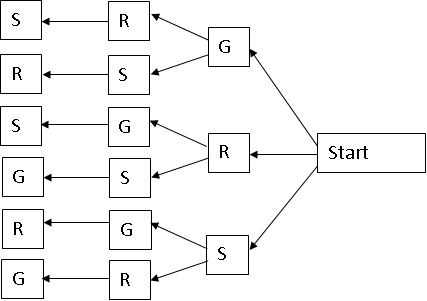
Figure 1
Refer Figure 1. For the first position from the right (or last position from the left) there are three options. For the second position from the right there will be two options per branch. And for the third and last position from the right only one option is left. If you now read and list all the branches from the left you get the 3 svara taana prastaar as given in Table 4.
Can you see music?
We can link colours of rainbow (spectrum of the white light, VIBGYOR) with the sapta svara. Svaras and their corresponding colours are given in Table 5. If we replace the svaras in Table 4 with their corresponding colours we can see the music. Refer Figure 2.
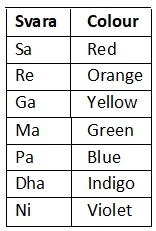
Table 5
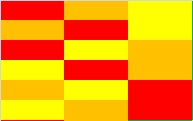
Figure 2
Now let us consider a 4 svara taana prastaar with the first four svaras Sa, Re, Ga and Ma. A 4 svara taana prastaar will have 4! = 24 taanas. The first taana of the prastaar will be the natural order of the svaras S R G M and the last taana will be the reverse order M G R S. The 4 svara taana prastaar will have four 3 svara prastaars embedded within it. Refer Table 6.

Table 6
Refer Figure 3. For the first position from the right (or last position from the left) there are four options. For the second position from the right there will be three options per branch. For the third position from the right there will be two options per branch. And for the fourth and last position from the right only one option is left. If you now read and list all the branches from the left you get the 4 svara taana prastaar as given in Table 6.
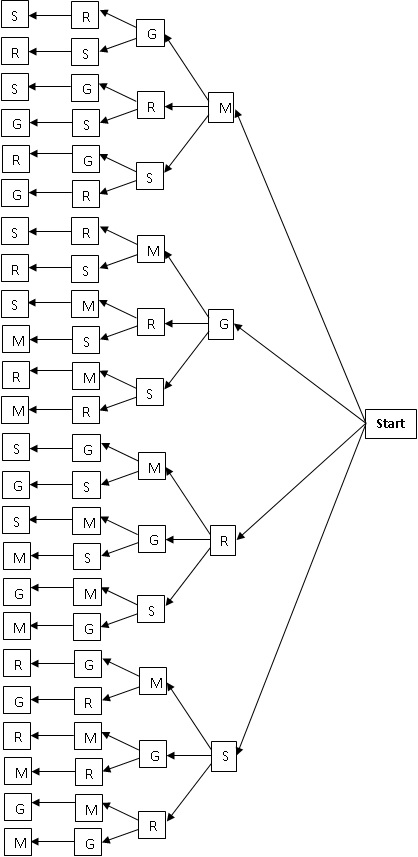
Figure 3
If we replace the svaras in Table 6 with their corresponding colours we can see the music for 4 svara taana prastaar. Refer Figure 4.
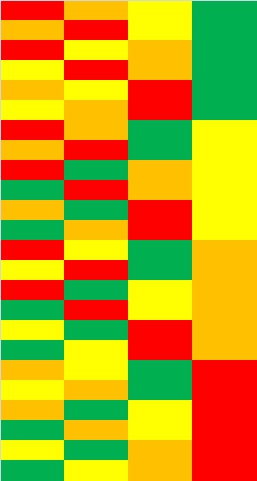
Figure 4
Carrying this forward a 7 svara taana prastaar will have 7! = 5040 taanas. It will have seven 6 svara taana prastaars embedded within it.
Let me now present the sutra that Sarngadeva gave to generate the taana prastaar :
क्रमं न्यस्य स्वरः स्थाप्यः पूर्वः पूर्वः परादधः।
स चेदुपरि तत्पूर्वः पुरस्तूपरिवर्तिनः॥
मूलक्रमक्रमात् पृष्ठे शेषाः प्रस्तार् ईदृशः। (सङ्गीतरत्नाकरः १.४.६२-६३)
- The first row will have all the svaras in their natural / original (ascending) order. The successive rows in the prastaar will be generated as the procedure given below.
- Starting from the left, identify the first svara which has at least one lower svara to its left (svaras are in ascending order). Below this, place the highest of these lower svaras (which are to its left).
- Then the svaras to the right are brought down as they are. The svaras left out are placed in the original order to the left, thus completing the next line of the prastaar.
The above procedure is repeated till you get the taana which is the reverse of the first row.
Let us now apply Sarngadeva’s sutra to the 16th row of Table 6 and get the 17th, 18th and the 19th row.
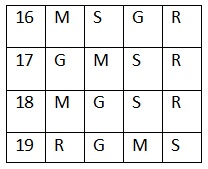
Table 7
Refer Table 7. In the 16th row we see that S G are in ascending order. Hence in the 17th row place S below G. Bring down R, which is to the right of G, as it is. The remaining svaras G and M are placed in their original order to the left of S.
In the 18th row we see that S R are in ascending order. Hence in the 19th row place S below R. The remaining svaras R, G and M are arranged in the original order to the left of S as shown in Table 7.
Let us now consider the last row of Table 6, M G R S. No two svaras are in ascending order hence the procedure comes to an end.
Sarngadeva’s sutra for the generation of the prastaar is applicable for the enumeration of the permutations of n elements with a natural order. Sarngadeva’s algorithm was one of the earliest and most sophisticated algorithms for combinatorial sequence generation.
Image credit: wikimedia.org
Disclaimer: The opinions expressed in this article belong to the author. Indic Today is neither responsible nor liable for the accuracy, completeness, suitability, or validity of any information in the article.

